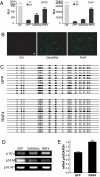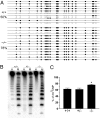Identification of RING finger protein 4 (RNF4) as a modulator of DNA demethylation through a functional genomics screen
- PMID: 20696907
- PMCID: PMC2930560
- DOI: 10.1073/pnas.1009025107
Identification of RING finger protein 4 (RNF4) as a modulator of DNA demethylation through a functional genomics screen
Abstract
DNA methylation is an important epigenetic modification involved in transcriptional regulation, nuclear organization, development, aging, and disease. Although DNA methyltransferases have been characterized, the mechanisms for DNA demethylation remain poorly understood. Using a cell-based reporter assay, we performed a functional genomics screen to identify genes involved in DNA demethylation. Here we show that RNF4 (RING finger protein 4), a SUMO-dependent ubiquitin E3-ligase previously implicated in maintaining genome stability, plays a key role in active DNA demethylation. RNF4 reactivates methylation-silenced reporters and promotes global DNA demethylation. Rnf4 deficiency is embryonic lethal with higher levels of methylation in genomic DNA. Mechanistic studies show that RNF4 interacts with and requires the base excision repair enzymes TDG and APE1 for active demethylation. This activity appears to occur by enhancing the enzymatic activities that repair DNA G:T mismatches generated from methylcytosine deamination. Collectively, our study reveals a unique function for RNF4, which may serve as a direct link between epigenetic DNA demethylation and DNA repair in mammalian cells.
Conflict of interest statement
The authors declare no conflict of interest.
Figures




Similar articles
-
SUMO-modification and elimination of the active DNA demethylation enzyme TDG in cultured human cells.Biochem Biophys Res Commun. 2014 May 9;447(3):419-24. doi: 10.1016/j.bbrc.2014.04.004. Epub 2014 Apr 12. Biochem Biophys Res Commun. 2014. PMID: 24727457
-
RING finger protein 4 (RNF4) derepresses gene expression from DNA methylation.J Biol Chem. 2014 Dec 5;289(49):33808-13. doi: 10.1074/jbc.C114.611558. Epub 2014 Oct 29. J Biol Chem. 2014. PMID: 25355316 Free PMC article.
-
E1B-55K-Mediated Regulation of RNF4 SUMO-Targeted Ubiquitin Ligase Promotes Human Adenovirus Gene Expression.J Virol. 2018 Jun 13;92(13):e00164-18. doi: 10.1128/JVI.00164-18. Print 2018 Jul 1. J Virol. 2018. PMID: 29695423 Free PMC article.
-
Role of base excision repair in maintaining the genetic and epigenetic integrity of CpG sites.DNA Repair (Amst). 2015 Aug;32:33-42. doi: 10.1016/j.dnarep.2015.04.011. Epub 2015 May 1. DNA Repair (Amst). 2015. PMID: 26021671 Free PMC article. Review.
-
DNA excision repair proteins and Gadd45 as molecular players for active DNA demethylation.Cell Cycle. 2009 May 15;8(10):1526-31. doi: 10.4161/cc.8.10.8500. Epub 2009 May 20. Cell Cycle. 2009. PMID: 19377292 Free PMC article. Review.
Cited by
-
SUMO: a multifaceted modifier of chromatin structure and function.Dev Cell. 2013 Jan 14;24(1):1-12. doi: 10.1016/j.devcel.2012.11.020. Dev Cell. 2013. PMID: 23328396 Free PMC article. Review.
-
Ing1 functions in DNA demethylation by directing Gadd45a to H3K4me3.Genes Dev. 2013 Feb 1;27(3):261-73. doi: 10.1101/gad.186916.112. Genes Dev. 2013. PMID: 23388825 Free PMC article.
-
Role of RNF4 in the ubiquitination of Rta of Epstein-Barr virus.J Biol Chem. 2013 May 3;288(18):12866-79. doi: 10.1074/jbc.M112.413393. Epub 2013 Mar 15. J Biol Chem. 2013. PMID: 23504328 Free PMC article.
-
Distribution, recognition and regulation of non-CpG methylation in the adult mammalian brain.Nat Neurosci. 2014 Feb;17(2):215-22. doi: 10.1038/nn.3607. Epub 2013 Dec 22. Nat Neurosci. 2014. PMID: 24362762 Free PMC article.
-
Emerging roles of TET proteins and 5-hydroxymethylcytosines in active DNA demethylation and beyond.Cell Cycle. 2011 Aug 15;10(16):2662-8. doi: 10.4161/cc.10.16.17093. Epub 2011 Aug 15. Cell Cycle. 2011. PMID: 21811096 Free PMC article. Review.
References
-
- Reik W. Stability and flexibility of epigenetic gene regulation in mammalian development. Nature. 2007;447:425–432. - PubMed
-
- Feinberg AP. Phenotypic plasticity and the epigenetics of human disease. Nature. 2007;447:433–440. - PubMed
-
- Esteller M. Cancer epigenomics: DNA methylomes and histone-modification maps. Nat Rev Genet. 2007;8:286–298. - PubMed
-
- Goll MG, Bestor TH. Eukaryotic cytosine methyltransferases. Annu Rev Biochem. 2005;74:481–514. - PubMed
-
- Bird A. DNA methylation patterns and epigenetic memory. Genes Dev. 2002;16:6–21. - PubMed
Publication types
MeSH terms
Substances
LinkOut - more resources
Full Text Sources
Other Literature Sources
Molecular Biology Databases
Research Materials
Miscellaneous

